One of the critical factors for achieving long term success with SEO is to know exactly how to run SEO campaigns.
It’s not only a matter of knowing how to begin an SEO campaign but it’s the steps taken before and after a campaign is completed.
I’ve been running SEO campaigns for more than 15 years and managed to achieve top Google rankings for many competitive terms in different niches by following the exact same process.
In this guide, you’ll learn how to start an SEO campaign and what specific steps to follow to increase your chances of running successful campaigns, over and over again.
What is an SEO Campaign?
An SEO campaign is a set of predefined steps to follow to improve the rankings of a website in the search results for specific keywords.
The difference between a dedicated SEO campaign and an on-going SEO process is that a campaign has specific measurable goals while the objective of on-going SEO is to improve the SEO performance of a website in general.
For best results, you should approach an SEO campaign like a project with a plan, tasks, milestones, and KPIs.
How to launch an SEO campaign
These are the steps to follow to run a successful SEO campaign:
- Analyze your website setup
- Perform an SEO Audit
- Set your Campaign Goals
- Perform Topic & Keyword Research
- Craft your Page Title
- Publish Great Content
- Work on On-Page SEO
- Promote your Content
- Monitor your SEO performance
- Build Topic Relevancy
1. Analyze your website setup
The first check to make before launching an SEO campaign is to review your website. This is a step you need to perform once-off to ensure that your website doesn’t have any major problems that can negatively affect the performance of your SEO campaigns.
For example, if your website is not mobile-friendly, then it is most likely that your campaigns will fail since mobile-friendliness is a huge ranking factor.
In general, before starting an SEO campaign, you need to ensure that:
- Your website is mobile-friendly
- It loads fast on both desktop and mobile
- Has SSL enabled
You can use the following resources to help you:
- How to perform a website review – a step-by-step guide on how to review your website setup.
- Page Speed – find out how to measure and improve your website’s page speed.
- HTTP to HTTPS – learn how to switch from HTTP to HTTPS without losing your SEO rankings.
If the above checks are successful then you can proceed with the next steps. If not then it is strongly recommended to solve any issues first otherwise it will be very difficult to run a successful SEO campaign.
2. Perform an SEO Audit
The next step is to review your website’s SEO healthiness by performing an SEO audit.
If you have recently performed an SEO audit then you don’t need to do this every time you start a new SEO campaign but if you haven’t done an audit yet, then this is a highly recommended step.
As part of the audit process, you need to review your technical SEO infrastructure and in particular the following items:
- Your URL structure – ensure that you have SEO friendly URLs
- Website structure – a good site structure is hierarchical (max 3 levels deep) and not flat
- Check how your canonical URLs are defined
- Optimize your txt SEO settings to avoid any indexing errors
- Ensure that your XML sitemap is optimized
3. Set your Campaign Goals
What differentiates an SEO campaign from a regular on-going SEO process is that an SEO campaign has specific goals and targets.
This means that before you start a campaign, you should specify exactly what you want to achieve. Some valid use cases are:
- To increase visibility on Google for keywords that you don’t have any presence yet.
- To improve the rankings of existing pages, for specific SEO keywords.
For example, before writing this guide I have set a very specific goal: to achieve high Google rankings for the term ‘SEO Campaign’.
To achieve my goal, my plan included the following steps:
- Write a comprehensive guide on ‘How to build an SEO Campaign’ (the post you’re reading now).
- Once the post is published to add internal links from older posts (this will help search engines discover the new post faster).
- Promote my posts on social media (through Facebook Ads and Twitter).
- Publish new posts related to running an SEO campaign and link to this post.
As you can see the steps are precise from start to finish. This helps you stay focus on what you have to do for this particular task.
Normally every SEO campaign that you run should be part of your overall SEO action plan. The action plan is based on your SEO strategy and can include one or more SEO campaigns.
4. Perform Topic & Keyword Research
Once your high-level goals are set, it’s time to make them more specific and the first actionable step is to perform a topic and keyword research.
What is the difference between a topic and a keyword? A topic is a set of related search terms while a keyword is something very specific. Here are some examples of topics and keywords.
Topics: Digital marketing, SEO, Outdoor camping
Keywords: Digital marketing courses, how to create an SEO campaign, where can I buy camping clothes.
The reason you need to do topic research first and not go directly into keyword research is to learn as many details as possible about your chosen topic and in particular things like:
- The total search volume for all keywords that make up a topic
- Competition levels
- Type of content that appears on the top of Google
Knowing this information in advance will help you design your SEO campaign to go after keywords that are realistic to target and not waste your time on keywords you cannot achieve high rankings.
Here is an overview of the process to follow:
- Go to Google and type in keywords you believe are related to the topic you’re targeting.
- Analyze the top 5 websites with your favorite keyword research tool.
- Find keywords that match your campaign goals and are feasible to target.
Step-By-Step Example
Let’s assume that you have a digital marketing blog (like the one you’re reading now) and want to begin an SEO campaign to target keywords related to ‘Facebook Marketing’.
The first step is to go to Google and type in the phrase ‘Facebook Marketing’.
Go through the results and open the first non-branded website in a new tab. In this case, it’s a post from HubSpot.
Scroll down the page and notice the type and length of the content. It’s a comprehensive post that coves all aspects of ‘Facebook Marketing’.
Copy the page URL and use your favorite keyword research tool to find out which keywords the particular page is ranking besides ‘Facebook Marketing’.
Go to SEMRUSH and enter the page URL.

Look at the section that shows you the most popular keywords the particular page is ranking for on Google.
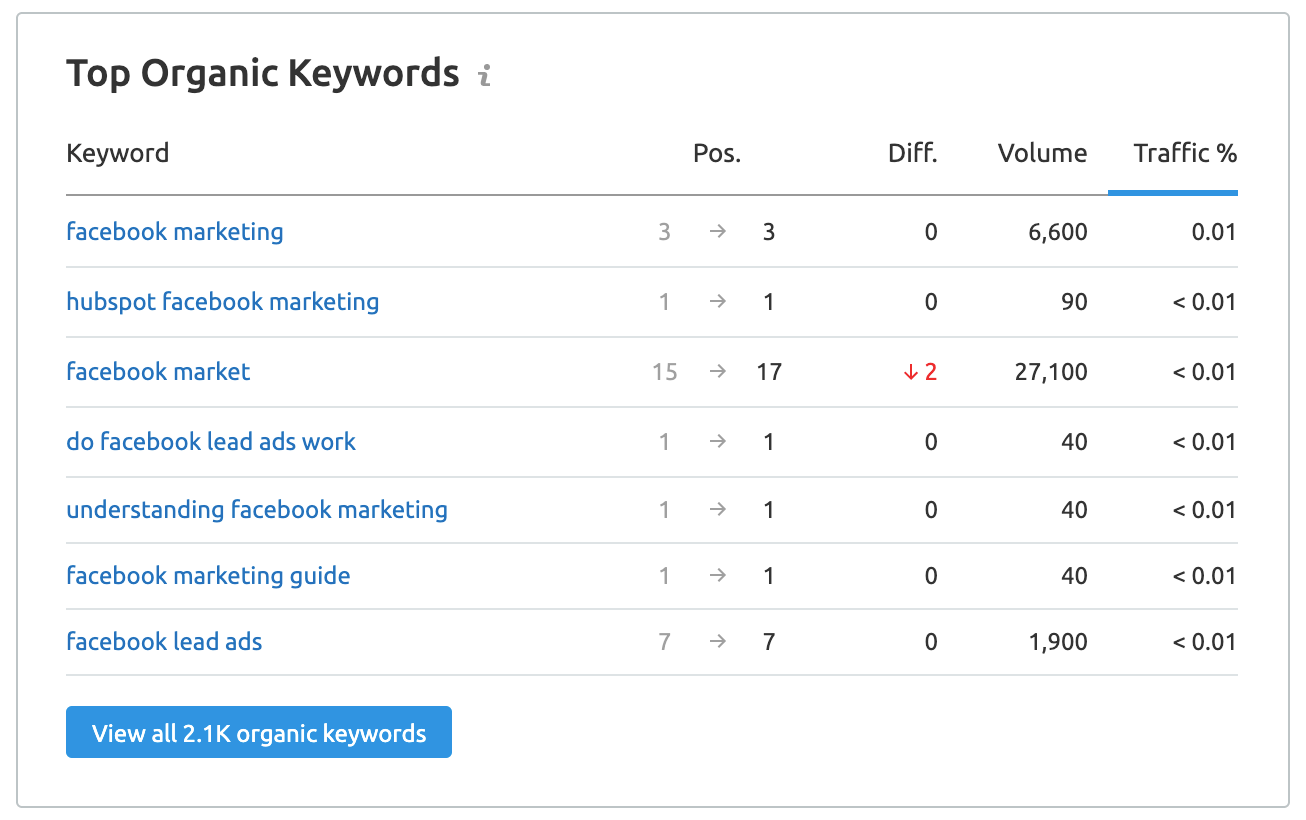
Repeat the process for the first 5 pages.
Once you study the results carefully, you’ll notice three things:
- ‘Facebook Marketing’ is a very popular search term.
- Only big and well-known websites are ranking on the first page of Google for this term.
- All results are long-form and detailed guides covering all aspects of ‘Facebook Marketing’.
This information tells me that it would be difficult to impossible to rank high for this term, especially if you take into account that my blog is not an authoritative blog on ‘Facebook’ related topics.
So, even If I start an SEO campaign to go after this specific term, it will fail. What is the solution?
To continue my keyword research and find out keywords that I can potentially rank for.
While in SEMRUSH click on ‘Facebook Marketing’. This will give you an analysis of the particular keyword.
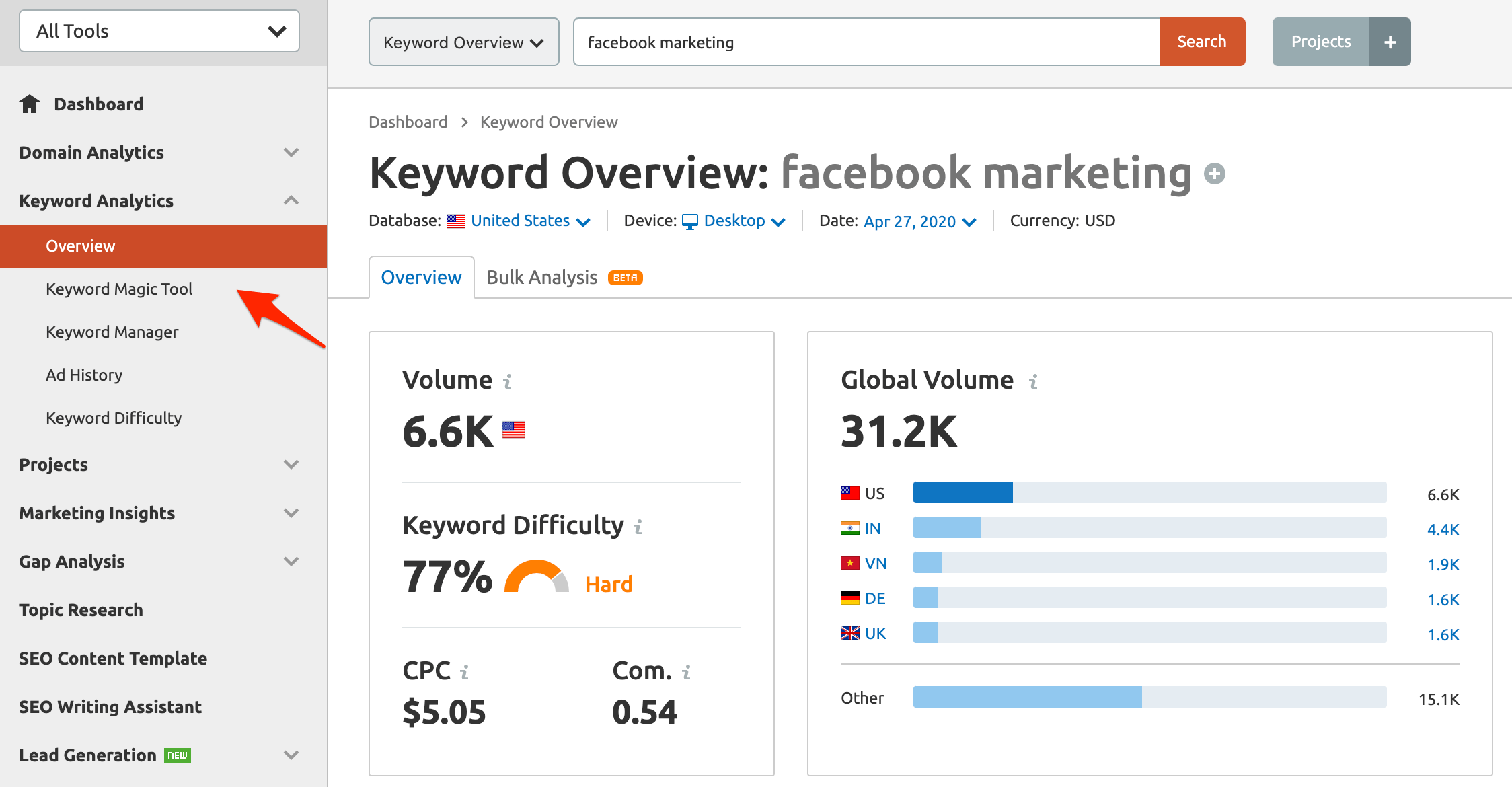
Then click on the KEYWORD MAGIC TOOL from the left menu
Since my blog is targeting small businesses, click on ‘business’ from the left menu. This will narrow down the results to only include keywords that are related to ‘Facebook marketing’ and business.
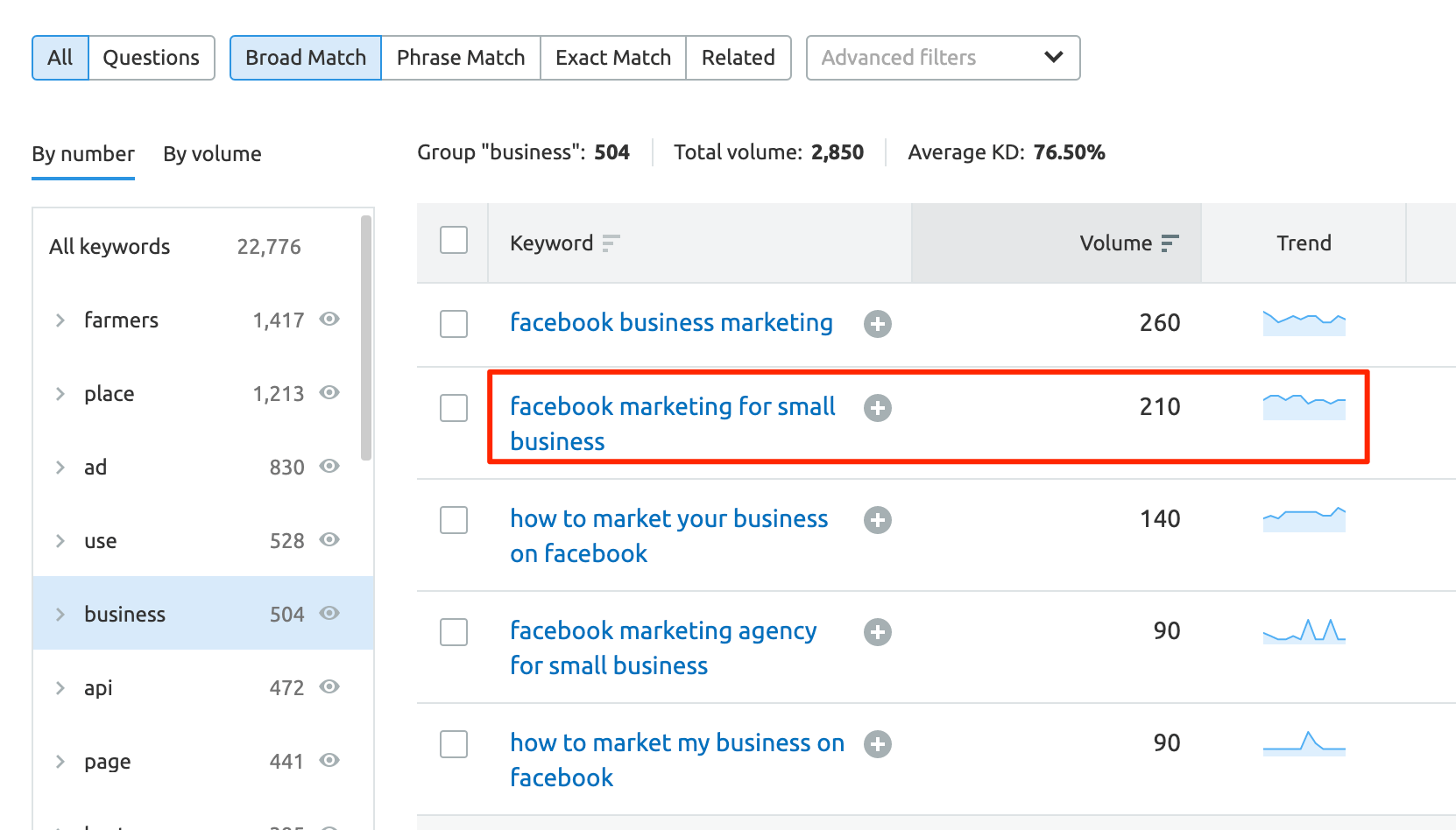
Immediately I can spot that ‘Facebook marketing for small business’ looks like a good candidate for my campaign.
It’s a long-tail keyword related to my goals, feasible to target and with a decent monthly search volume.
Go back to Google and search for ‘Facebook Marketing for small business’. You’ll now notice that not all the results are occupied by big and well-known websites and that the type of content is not as thorough as in the case of ‘Facebook Marketing’.
In other words, going after the term ‘Facebook marketing for small business’ is a better choice than going after ‘Facebook Marketing’.
Yes, the search volume is less but your chances of ranking for this term are much higher and this, in turn, increases your chances of running a successful SEO campaign.
5. Craft your Page Title
The next step before writing the content is to craft your page title. The page title is the most important SEO element and besides being SEO friendly, it has to be unique and enticing for the users to click on.
Follow the tips below:
- Perform a Google search using your chosen keywords
- Look at the results that appear on the first page
- Create a title that contains your target keywords but is not the same as what is already available on Google.
In our example, if you search for “Facebook Marketing for Small Business”, you’ll notice that none of the results has this title so this gives me the green light to use this title.
To make your title more interesting to users, you can add brackets and words like ‘Complete’, ‘Ultimate’,’Easy’,’ Step-by-Step’.
In our example, the final title will be ‘Facebook Marketing for Small Business (Complete Guide)’.
Page title optimization – A step-by-step guide on how to write SEO friendly titles.
6. Publish Great Content
The next step is to write the content for your post, taking into account the following:
Make it better – In order to have any chances of ranking in the top positions of Google, your content has to be better than what is already available. Carefully examine the existing content and think of ways you can make your content better.
Always consider the user and what they might like to see for a particular search query. For example, if you’re writing a post comparing different tools then a comparison table might be a good fit. If you’re writing a ‘how-to’ article then step-by-step instructions with images may be more appropriate than just plain text.
Don’t take for granted that what is already ranking on Google is the best type of content. In the majority of cases, there are always things that can be improved if you approach the content creating process from a different angle.
Write in-depth content – For any chosen topic or keyword, there are probably hundreds of pages competing for a first-page ranking. Many studies have shown that long-form in-depth content, known as pillar pages, tend to show up more frequently in organic search.
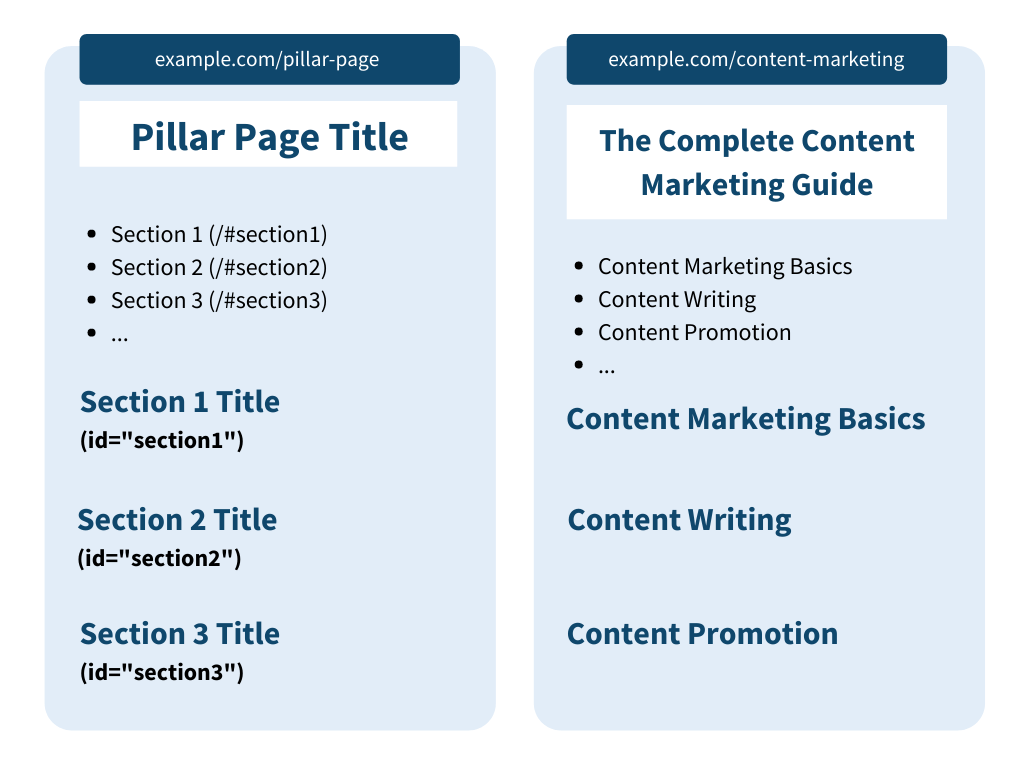
This does not mean that writing more words will guarantee higher rankings, there is no ideal blog post length. But, writing in-depth guides that make sense and cover all aspects of a topic, will certainly help.
Be transparent – Don’t hide important information from users but be transparent. For example, if you’re writing a blog post that contains affiliate links, make sure you mention this at the beginning of the post and don’t’ hide this info in your footer or small letters.
Make it clear to users who is the author of the post and how they can find out more details or contact the author if needed.
Make sure that you back-up any claims made in your content with real data or studies.
Demonstrate your authority and expertise – For certain topics and keywords is not enough to show who wrote the post but it’s necessary to mention why users should trust the advice given by the author.
For example, you won’t be able to rank on Google for health-related topics unless the content is written and verified by certified experts.
E-A-T which stands for Expertise, Authoritativeness, and Trustworthiness, are elements that are part of the Google ranking factors, and they directly or indirectly affect the position a website will appear in Google search results.
Be different – Writing the same content in different words is not the best approach to follow. Instead, try to come up with something different than what is already on Google. This way users will have an alternative resource to learn more about a topic and Google likes that.
Resources to Learn More
- SEO Best Practices – A checklist to follow to ensure that your content adheres to best SEO practices.
- SEO Friendly Content – Tips on how to write content that is search engine friendly.
Pro Tip: If your SEO campaign goals are to get organic traffic for topics that you don’t already have any presence at all, then you can consider creating a topic cluster. A topic cluster is a collection of pillar pages and non-pillar pages, related to the same topic. For more information read this guide.
7. Work on Your On-Page SEO
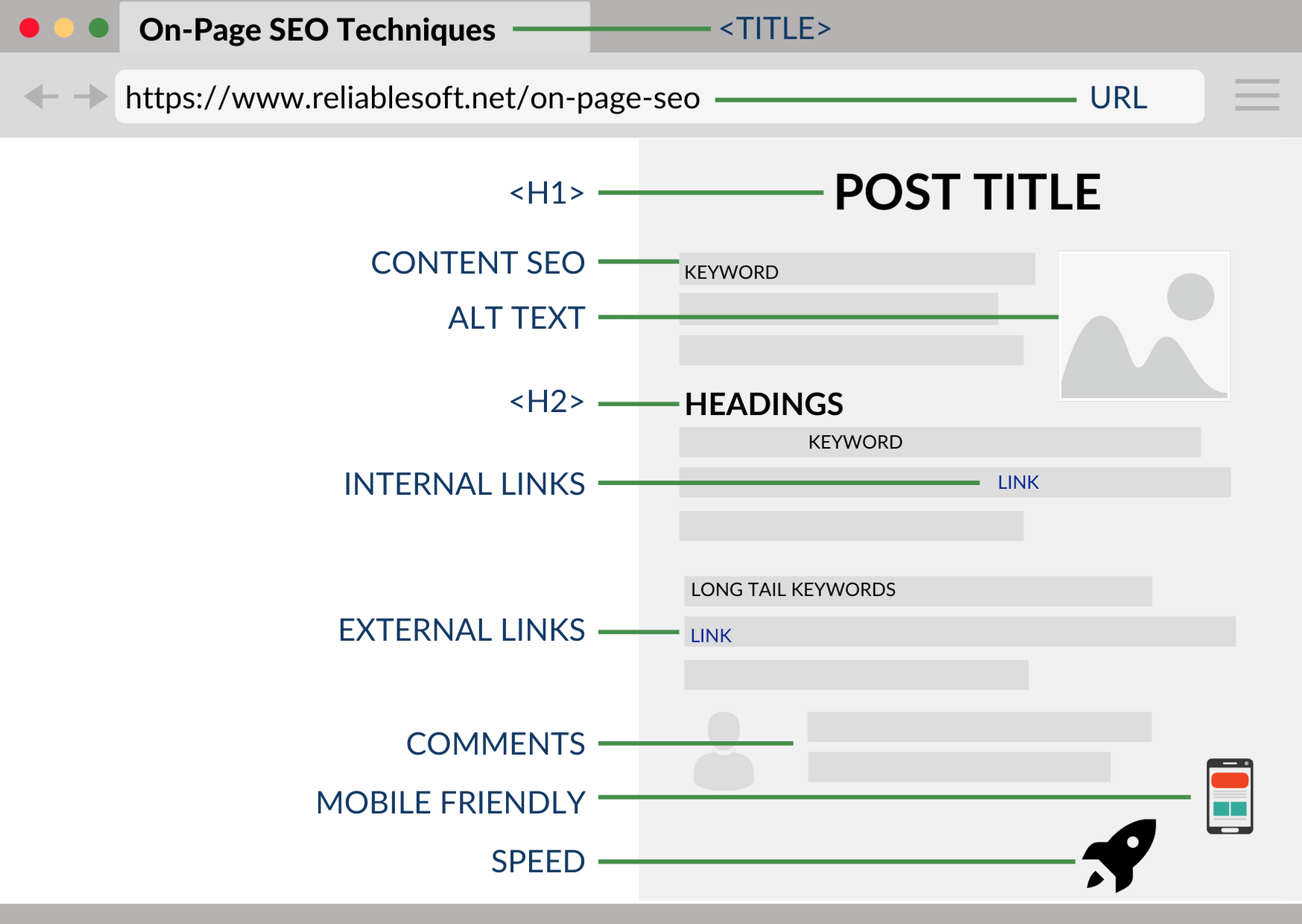
Once you’re done with content writing and before hitting the publish button, you need to make sure that your content is optimized for on-Page SEO.
SEO friendly content makes the job of search engines easier and this can potentially translate to higher rankings.
Follow these simple SEO tips:
- Add your target keyword in the URL slug.
- Mention your target keyword in your opening paragraph.
- Mention your target keyword in your H1 Tag.
- Add related keywords in your H2 and H3 tags.
- Add long-tail keywords and semantically related keywords in your content.
- Add images and make sure that you optimize the ALT Text.
Resources to Learn More
- SEO tips for beginners – Includes examples on how to maximize your on-page SEO efforts.
- SEO Blog writing – How to optimize your blog post’s content.
8. Promote your Content (Internally and Externally)
No SEO campaign is complete without content promotion. Finding the right keywords and publishing awesome content is the first step, the second step is promoting your content.
There are two ways to effectively do this:
- Promote your content internally (also known as internal linking).
- Promote your content externally (also known as off-page SEO).
Promote your content with internal linking
After you publish a post, find related pages on your website and add internal links pointing to the new post. Optimize the anchor text of your internal links to match the keywords you want to rank for.
For example, after publishing this post, I will find other pages on my website that mention and words ‘SEO campaign’ and I will link to this post.
From experience, this is a step that many webmasters ignore and it’s a big SEO mistake.
By adding internal links from old posts, you help search engines discover your new pages and they also get a share of the PageRank which helps new content rank faster.
Promote your content externally
This is referred to as link building which is the process of building backlinks from other websites. Good quality backlinks act as ‘votes of trust’ and this helps page rank higher in the search results.
Sending unsolicited emails to hundreds of webmasters begging for links is not the best way to promote your content. What you should do instead is to strategically reference other websites in your content and great a list of people that would love to promote your content.
Don’t forget that besides link building, there are other ways to promote your content like running paid campaigns on Facebook, sending out a newsletter, and informing your list of influencers.
My previous guide on the best content promotion methods has all the details.
9. Monitor your SEO performance

As mentioned in the beginning, one of the characteristics that differentiate an SEO campaign from other SEO tasks is that it has milestones and certain KPIs you can use to monitor its performance.
To be more precise, you can evaluate the effectiveness of your SEO campaigns using the following metrics:
- Ranking position in Google
- Number of visits
- Number of backlinks
- Number of social shares
- Number of comments
- Bounce Rate
You can get this information from your Google Search Console account and Google Analytics SEO reports or by using a tool like SEMRUSH.
What is important to know is the following:
The results of an SEO campaign you start now will be visible in 6 months or more. It takes a LONG time for new content to reach it’s final ranking position so don’t rush into making conclusions too soon.
Set a reminder in your calendar to check on a monthly basis the ranking position of the content in Google. You can use a dedicated tool or the Performance report of Google Search Console.
Besides promoting your content internally or externally, don’t make any other changes to the content until it gets to its final positions. You can then decide if you need to adjust your title or change the content.
While waiting for your content to mature, you can proceed with the next step (if applicable) or start new SEO campaigns targeting other topics and keywords.
What to do after the 6-month period?
Come back and check for which keywords the page is ranking. In some cases, it might not be the same keywords as you expected the page to rank so you might have to adjust your page title and content to either match what Google believes or try to add give more signals to search engines as to which keywords you want the page to rank.
This is an advanced SEO concept and I know that for beginners to SEO is too complicated or confusing to understand. The bottom line is that by adjusting your SEO campaigns after you have the real picture of what a page can realistically achieve in terms of rankings, can help you optimize the number of search visits you can get from each piece of content you publish.
10.Build topic relevancy
The next and final step of your SEO campaign is to decide whether you need to publish more content related to the same topic to start building what is called topic relevancy.
The theory behind topic relevancy is the following:
- Google while ranks pages individually it does take into account the website content it is published on.
- Websites that are considered as authoritative for a particular topic are likely to rank easier to topic-related keywords.
How is this related to your SEO campaign?
If your goal is to achieve rankings for a topic you have no presence yet, then you’ll need to publish more related content and not just a single post.
You can start by publishing a post targeting the most important topic keywords and then gradually publish more content. In the new content make sure that you link to your older post using anchor text that includes the pages you want to rank for.
Key Learnings
One of the best ways to maximize the return of SEO is to run targeted SEO campaigns. By breaking down your overall SEO goals into smaller tasks and running an SEO campaign for each, you’ll be able to achieve better results.
An SEO campaign needs to have specific goals and targets and it’s normal to have a number of SEO campaigns running in parallel.
Before you start a campaign, it is highly recommended to review your website setup and overall SEO healthiness by running an SEO audit. Any critical issues in your setup or technical SEO can negatively affect the performance of your SEO campaigns.
Once you find and fix any issues, then you don’t have to do this every time you start a new campaign.
An SEO campaign starts by setting up specific measurable goals and by finding the right keywords or topics to target with your content.
Once you have this information on hand, the next step is to create the content, optimize it for SEO, and publish it.
After you hit the publish button, you need to allocate the necessary time to promote your new content using both internal and external methods.
Once you are past this step, you can safely move on to launch a new SEO campaign (targeting different topics and keywords) but don’t forget to come back every month and monitor the performance of your running campaigns.
Depending on the results, you may have to adjust your page title and content or pay more attention to off-site promotion to ensure that the right signals are given to search engines.





Very good article. Thanks a lot Alex.
Nice content Alex, working on it right now.